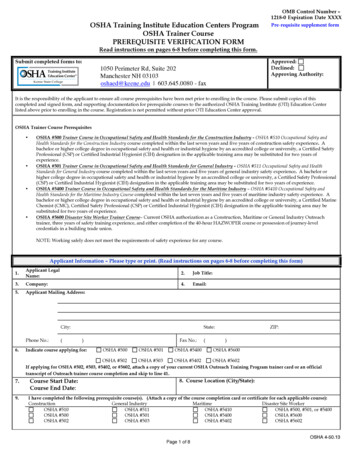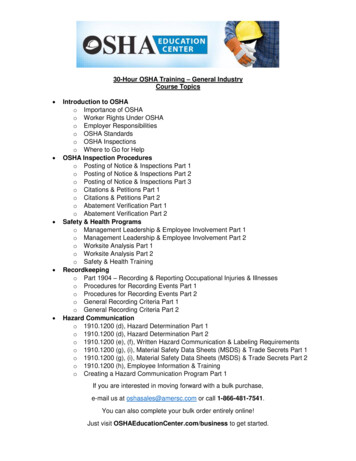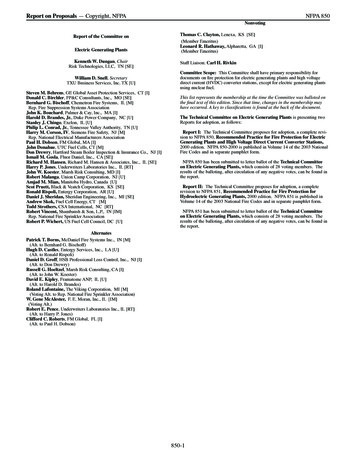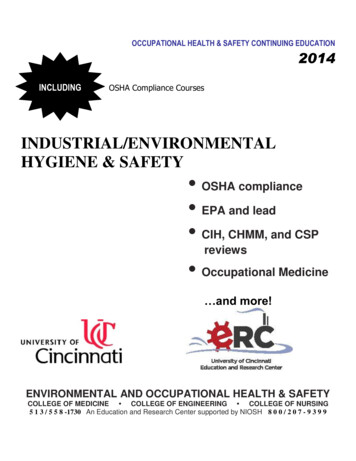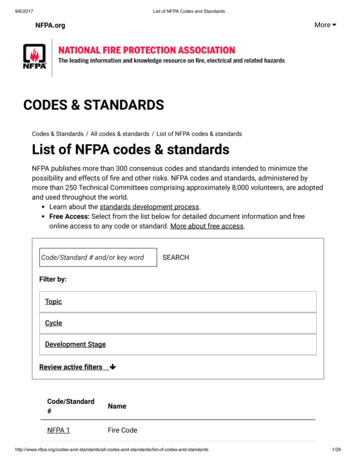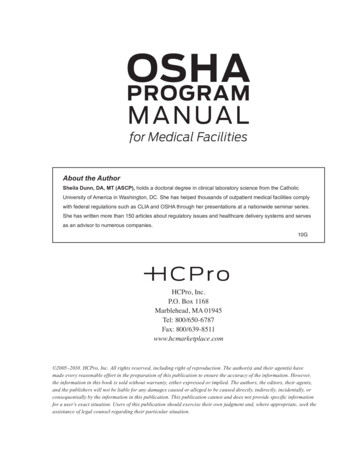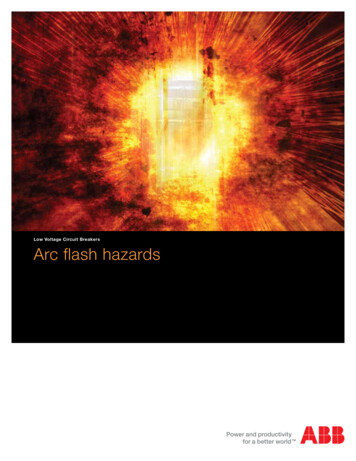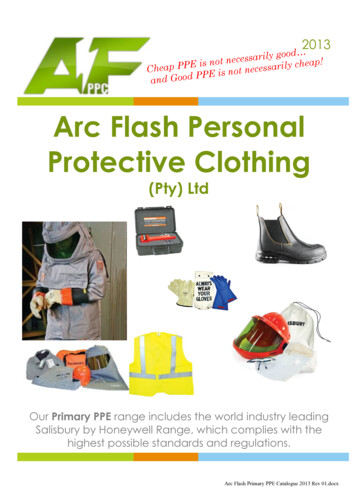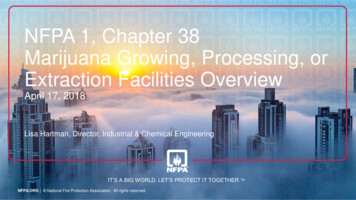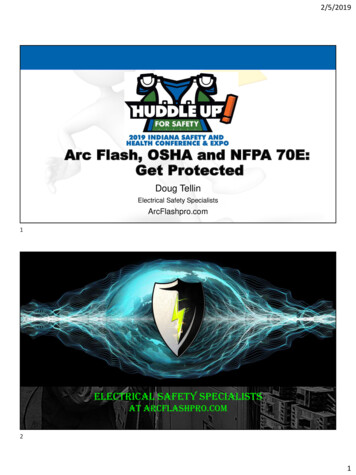
Transcription
2/5/2019Arc Flash, OSHA and NFPA 70E:Get ProtectedDoug TellinElectrical Safety SpecialistsArcFlashpro.com1Electrical Safety SpecialistsAt ArcFLAshpro.com21
2/5/20191 out of 300SafetyOverall1 out of 101Fatality1FatalityElectricalSafety30 Lost-TimeInjuries300 Recordable Injuries10 Recordable Injuries30,000 Near Misses300,000 At-Risk BehaviorsElectrical Safety should be a MAJOR concern!342
2/5/2019 OSHA historically hasencouraged companies to: De-energize circuits beforeworking on them. Perform lockout/tagoutprocedures Develop ongoing safetyprograms including trainingand retraining for workers5 Never work on live circuits unless it isabsolutely necessary. OSHA has strict guidelines for working livecircuits. Production or inconvenience is notjustification for working energized. Not having the authority to shut off power,cannot be used as an excuse for workers.63
2/5/2019 Was an arc flash hazard analysis performed? Were flash protection boundaries established? Were all other potential electrical hazardsidentified? Was a shock hazard analyses performed? Were shock hazard boundaries established? These are all Questions every EHSprofessional should have an answer to.7The employer must show proof of the appropriatetraining and certifications for a person to bedeemed qualified in OSHA’s Eyes This is achieved by training, even for theexperienced electrician.84
2/5/2019Inspector will "focus" on these four hazard areas: Falls Struck by Caught in/between Electrical9OSHA’S INSPECTIONSExampleOSHA Citation105
2/5/2019OSHA’S INSPECTIONSExampleOSHA Citation11.Lack of protective equipment for Republic Steel plant electrician results in1st and 3rd degree burns after arc flashSteel manufacturer faces 147K in fines for "avoidable" hazardsBUFFALO, New York – An electric technician at the Republic Steel Corp. steel manufacturingplant in Blasdell was removing wiring from a fan motor in an overhead crane on October 16,2014, when an ungrounded electrical conductor touched a grounded surface causing an arcflash. The electric technician sustained third degree burns on her hand and first degree burnson her face.An investigation by the Buffalo Area Office of the U.S. Department of Labor's OccupationalSafety and Health Administration found that Republic Steel failed to provide and ensure the useof effective face and hand protection by its employees."These injuries were avoidable. Republic Steel has a responsibility to make sure that its electrictechnicians are properly trained, equipped with and using personal protective equipment toprotect from arc flash. In this case, that would include a face shield and rubber insulatinggloves. The company should be especially aware of this, since OSHA cited Republic Steel earlierin 2014 for similar hazards at its Lorain, Ohio, facility," said Michael Scime, OSHA's area directorin Buffalo.As a result of these conditions, OSHA cited Republic Steel for two repeat violations, withproposed penalties of 70,000 each for the lack of hand and face protection. The steelmanufacturer was also cited for one serious violation, with a 7,000 fine, for failing to protectemployees against contact with energized electrical equipment. Total proposed penalties are 147,000126
2/5/2019NFPA 70E 2018 has set the bar pretty high. Qualified workers within Limited Approach Boundary!Documented Proficiency in Safe Work Practices!Annual inspections of employee performance!Release of victims training AnnuallyElectrical safety program audits every 3 years!Retraining every 3 years!NPFA70, NFPA 70E, NFPA 70B, NFPA 99 are all trade marks ofthe National Fire Protection Association, INC13Article 90 - IntroductionArticle 100 - DefinitionsArticle 105 - Application of Safety-Related Work PracticesArticle 110 - General Requirements for Electrical SafetyRelated Work PracticesArticle 120 - Establishing an Electrically Safe Work ConditionArticle 130 - Work Involving Electrical HazardsSource NFPA 70E 2018147
2/5/2019105.3 Responsibility.A. Employer Responsibility. The employer shall have thefollowing responsibilities:1. Establish, document, and implement the safety-related workpractices and procedures required by this standard.2. Provide employees with training in the employer’s safety-relatedwork practices and procedures.B. Employee Responsibility. The employee shall comply with thesafety-related work practices and procedures provided by theemployerSource NFPA 70E 201815105.4 Priority. Hazard elimination shall be the first priority in theimplementation of safety related work practices.Source NFPA 70E 2018168
2/5/2019(B) Inspection. The electrical safety program shall include elements toverify that newly installed or modified electricalequipment or systems have been inspected to apply withapplicable installation codes and standards prior to beingplaced into service.Source NFPA 70E 201817(C) Condition of Maintenance. The electrical safety program shall include elements thatconsider condition of maintenance of electricalequipment and systems.Source NFPA 70E 2018189
2/5/2019(H) Risk Assessment Procedure The electrical safety program shall include a risk assessment procedure andshall comply with 110.1(H)1 through 110.1(H)3.1. Elements of a risk assessment procedure. The risk assessment procedureshall address employee exposure to electrical hazards and shall identify theprocess to be used by the employee before work is started to carry out thefollowing:(1) Identify hazards(2) Assess risks(3) Implement risk control according to a hierarchy of risk controlmethodsSource NFPA 70E 201819(H) Risk Assessment Procedure2. Human Error. The risk assessment procedure shall address the potential for humanerror and its negative consequences on people, process, the workenvironment, and equipment.Source NFPA 70E 20182010
2/5/2019(H) Risk Assessment Procedure3. Hierarchy of Risk Control Methods. The risk assessment procedure shall require that preventive and protective riskcontrol methods be implemented in accordance with the following hierarchy:1. Elimination2. Substitution3. Engineering controls4. Awareness5. Administrative controls6. PPESource NFPA 70E 201821(K) Auditing.1. Electrical Safety Program Audit.The electrical safety program shall be audited to verify that theprinciples and procedures of the electrical safety program are incompliance with this standard. Audits shall be performed atintervals not to exceed 3 years.Source NFPA 70E 20182211
2/5/2019(K) Auditing.2. Field Work Audit. Field work shall be audited to verify that the requirementscontained in the procedures of the electrical safety programare being followed. When the auditing determines that theprinciples and procedures of the electrical safety programare not being followed, the appropriate revisions to thetraining program or revisions to the procedures shall bemade. Audits shall be performed at intervals not to exceed 1year.Source NFPA 70E 201823(K) Auditing.3. Lockout/Tagout Program and Procedure Audit. The lockout/tagout program and procedures required by Article 120 shallbe audited by a qualified person at intervals not to exceed 1 year. The auditshall cover at least one lockout/tagout in progress. The audit shall bedesigned to identify and correct deficiencies in the following:1. The lockout/tagout program and procedures2. The lockout/tagout training3. Worker execution of the lockout/tagout procedure4. Documentation. The audits required by 110.1 (K) shall be documented.Source NFPA 70E 20182412
2/5/2019(A)(1) Qualified Person. A qualified person shall be trained and knowledgeable in theconstruction and operation of equipment or a specific workmethod and be trained to identify and avoid the electricalhazards that might be present with respect to that equipmentor work method.a. Such persons shall also be familiar with the proper use ofthe special precautionary techniques, applicable electricalpolicies and procedures, PPE, insulating and shieldingmaterials, and insulated tools and test equipment.Source NFPA 70E 201826(A)(1) Qualified Person.b.c.A person can be considered qualified with respect to certain equipmentand tasks but still be unqualified for others.Such persons permitted to work within the LAB shall, at a minimum, beadditionally trained in all of the following:1. Skills and techniques necessary to distinguish exposed energizedelectrical conductors and circuit parts from other parts ofelectrical equipment2. Skills and techniques necessary to determine the nominal voltageof exposed energized electrical conductors and circuit parts3. The approach distances specified in Table 130.4(D)(a) and Table130.4(D)(b) and the corresponding voltages to which the qualifiedperson will be exposedSource NFPA 70E 20182713
2/5/2019(A)(1) Qualified Person.4. Decision-making process necessary to be able to do thefollowing:a.b.c.d.Perform the job safety planningIdentify electrical hazardsAssess the associated riskSelect the appropriate risk control methods from thehierarchy of controls. including personal protectiveequipmentSource NFPA 70E 201828Qualified Person.One who has demonstrated skills and knowledgerelated to the construction and operation of electricalequipment and installations and has received safetytraining to identify and avoid the hazards involved.Source NFPA 70E 20182914
2/5/2019Qualified Person.The latest revision of the OSHA definition for qualified person(1910.399 8/07) includes the phrase“has demonstrated skills.”To meet this requirement, the person has to actuallydemonstrate that he/she can perform the task.Source NFPA 70E 201830(C) Emergency Response Training(1) Contact Release. Employees exposed to shock hazards and those responsible forthe safe release of victims from contact with energizedelectrical conductors or circuit parts shall be trained inmethods of sale release. Refresher training shall occurannually.Source NFPA 70E 20183115
2/5/2019Caution!If a victim is being shocked bygreater than 600v do notremove victim from live circuitwithout specialized training andequipment. Disconnect powerbefore entering the area.Source NFPA 70E 2018321. Remove Source of Electricity Check the scene for safety turn ofpower or use non conductive tool or item if source power isnot known2. Check for consciousness3. Request Emergency Assistance4. Emergency First-Aid CPR (cardiopulmonary resuscitation) AED (automatic external defibrillatorSource NFPA 70E 20183316
2/5/2019(C) Emergency Response Training(2) First Aid, Emergency Response, and Resuscitation.a) Employees responsible for responding to medical emergenciesshall be trained in first aid and emergency procedures.(Periodically)b) Employees responsible for responding to medical emergenciesshall be trained in cardiopulmonary resuscitation (CPR).Source NFPA 70E 201834(C) Emergency Response Training(2) First Aid, Emergency Response, and Resuscitation.c) Employees responsible for responding to medical emergenciesshall be trained in the use of an automated external defibrillator(AED) if an employer’s emergency response plan includes theuse of this device.d) Training shall occur at a frequency that satisfies therequirements of the certifying body.Source NFPA 70E 20183517
2/5/2019(C) Emergency Response Training(3) Training Verification.Employers shall verify at least annually that employee training required by110.2(C) is current.(4) Documentation. The employer shall document that the training requiredby 110.2(C) has occurred.Source NFPA 70E 201836(A)(1)(e) Qualified Person. Employees shall be trained to select an appropriate test instrumentand shall demonstrate how to use a device to verify the absence ofvoltage . The training shall include information that enables the employee tounderstand all limitations of each test instrument that might be used.Source NFPA 70E 20183718
2/5/2019(A)(1)(f) Qualified Person. The employer shall determine through regular supervision or throughinspections conducted on at least an annual basis that each employeeis complying with the safety-related work practices required by thisstandard.Source NFPA 70E 201838(A)(3) RetrainingAn employee shall receive additional training (or retraining) if any of thefollowing conditions exists:(1) The supervision or annual inspections indicate that the employee is not complyingwith the safety-related work practices.(2) New technology, new types of equipment, or changes in procedures necessitate theuse of safety-related work practices that are different from those that the employeewould normally use.(3) The employee needs to review tasks that are performed less often than once peryear.(4) The employee needs to review safety-related work practices not normally used bythe employee during regular job duties.(5) The employee’s job duties change.Source NFPA 70E 20183919
2/5/2019(A)(5) Electrical Safety Training Documentation. The employer shall document that each employee has received thetraining required by 110.2(A). This documentation shall be made when the employee demonstrates proficiency in thework practices involved and shall be maintained for the duration of the employee’semployment. The documentation shall contain the content of the training, each employee’s name,and dates of training.40(A)(2) Unqualified Person Unqualified persons shall be trained in, and be familiar with, anyelectrical safety related practices necessary for their safety.Source NFPA 70E 20184120
2/5/2019ProperUse of TestInstruments42110.4(B) Rating. Test Instruments, equipment, and their accessories shall be asfollows:1. Rated for circuits and equipment where they are utilized.2. Approved for the purpose.3. Used in accordance with any instructions provided by themanufacturer.Source NFPA 70E 20184321
2/5/2019110.4 (D) Visual Inspection and Repair.Test instruments and equipment and all associated: test leads cables, power cords probes connectorsshall be visually inspected for external defects and damage beforeeach use.Source NFPA 70E 201844110.4 (E) Operation Verification. When test instruments are used for testing the absence ofvoltage on conductors or circuit parts operating at voltagesequal to or greater than 50 volts, the operation of the testinstrument shall be verified on any known voltage sourcebefore and after an absence of voltage test is performed.Source NFPA 70E 20184522
2/5/2019110.4(A) Testing. Only qualified persons shall perform tasks such as testing,troubleshooting, and voltage measuring on electrical equipmentoperating at voltages equal to or greater than 50 volts.Source NFPA 70E 201846OSHA 1910.334(c) “Test instruments and equipment”1910.334(c)(2)"Visual inspection." Test instruments and equipmentand all associated test leads, cables, power cords,probes, and connectors shall be visually inspected forexternal defects and damage before the equipment isused.4723
2/5/2019ANSIThis standard establishes an important four-category system for rating theelectrical hazards electricians face when taking measurements on so-called“low voltage” equipment — up to 1000 volts.48Most digital multimeters (DMMs) display these ratings nearthe voltage/current input terminals. What is your meter CATrating? Have you checked yours?4924
2/5/2019What are we going to coverVerification of an Electrically Safe WorkCondition50120.5 Process for Establishing and Verifying an Electrically Safe WorkCondition. 1.Establishing and verifying an electrically safe work condition shallinclude all of the following steps, which shall be performed in theorder presented, if feasible:Determine all possible sources of electrical supply to thespecific equipment. Check applicable up-to-date drawings,diagrams, and identification tags.Source NFPA 70E 20185125
2/5/2019120.5 Process for Establishing and Verifying an ElectricallySafe Work Condition.2. After Properly Interrupting the load current, open thedisconnecting device(s) for each source.Source NFPA 70E 201852120.5 Process for Establishing and Verifying an ElectricallySafe Work Condition.3. Wherever possible, visually verify that all blades of thedisconnecting devices are fully open or that draw out-typecircuit breakers are withdrawn to the fully disconnectedposition.Source NFPA 70E 20185326
2/5/2019120.5 Process for Establishing and Verifying an ElectricallySafe Work Condition.4. Release stored electrical energy.5. Release or block stored mechanical energy.Source NFPA 70E 201854120.5 Process for Establishing and Verifying an ElectricallySafe Work Condition.6. Apply lockout/tagout devices in accordance with a documentedand established procedure.Source NFPA 70E 20185527
2/5/2019120.5 Process for Establishing and Verifying an Electrically SafeWork Condition.7. Use an adequately rated portable test instrument to test each phaseconductor or circuit part to verify it is de-energized. Test each phaseconductor or circuit part both phase-to-phase and phase-to-ground. Before and after each test, determine that the test instrument isoperating satisfactorily, through verification on a known voltagesource.Source NFPA 70E 201856120.5 Process for Establishing and Verifying an Electrically SafeWork Condition.7. Continued: Exception No. 1: An adequately rated permanently mounted test device shall bepermitted to be used to verify the absence of voltage of the conductors or circuitparts at the work location, provided it meets all of the following requirements:1. It is permanently mounted and installed in accordance with the manufacture'sinstructions and tests the conductors and circuit parts at the point of work.2. It is listed and labeled for the purpose of verifying the absence of voltage.3. It tests each phase conductor or circuit part both phase-to-phase and phase-toground.4. The test device is verified as operating satisfactorily on any known voltage sourcebefore and after verifying the absence of voltage.5728
2/5/2019120.5 Process for Establishing and Verifying an Electrically SafeWork Condition.7. Continued: Exception No. 2: On electrical systems over 1000 volts, noncontact test instrumentsshall be permitted to be used to test each phase conductor.Source NFPA 70E 201858120.5 Process for Establishing and Verifying an Electrically SafeWork Condition.8. Where the possibility of induced voltages or stored electrical energyexists, ground the phase conductors or circuit parts before touching them.Where it could be reasonably anticipated that the conductors or circuitparts being deenergized could contact other exposed energizedconductors or circuit parts, apply temporary protective groundingequipment in accordance with the following:Source NFPA 70E 20185929
2/5/2019120.5 Process for Establishing and Verifying an Electrically Safe WorkCondition.8. Continued:a)Placement. Temporary protective grounding equipment (TPGE) shall be placedat such locations and arranged in such a manner to prevent each employeefrom being exposed to a shock hazard. The location sizing and application ofTPGE shall be identified as part of the employee’s job planning.b)Capacity. TPGE shall be capable of conducting the maximum fault current thatcould flow at the point of grounding for the time necessary to clear the fault.c) Impedance. TPGE and connections shall have an impedance low enough tocause immediate operation of protective devices in case of unintentionalenergizing of the electrical conductors or circuit parts.Source NFPA 70E 2018601. Determine all sources of electricity2. Properly interrupt the load3. Open all disconnecting means4. Visually verify open disconnects (When Possible)5. Release stored electrical energy6. Release or block stored mechanical energy7. LOTO8. Verify Meter CAT #, Physical Condition, and Known Power source9. Verify absence of voltage10. Verify meter known power source11. Ground if determined necessary6130
2/5/2019120.1 Lockout/ Tagout Program(A) General. Each employer shall establish, document, and implement a lockout/tagoutprogram. The LOTO program shall specify LOTO procedures to safeguardworkers to exposure form electrical hazards. The LOTO program and proceduresshall also incorporate the following:1. Be applicable to the experience and training of the workers and conditions inthe workplace.2. Meet the requirements of Article 120.3. Apply to fixed, permanently installed equipment, temporary installedequipment, and portable equipment.Source NFPA 70E 201862120.1 Lockout/ Tagout Program(B) Employer responsibility. The employer shall be responsible for the following:1. Providing the equipment necessary to execute lockout/tagoutprocedures2. Providing LOTO training to workers in accordance with 110.23. Auditing the LOTO program in accordance with 110.14. Auditing execution of the LOTO procedures in accordance with 110.1Source NFPA 70E 20186331
2/5/2019120.2 Lockout/ Tagout Principles(A) General. Electrical conductors and circuit parts shall not be considered to be in anelectrically safe work condition until all of the requirements for Article120 have been met. Safe work practices applicable to the circuit voltage and energy level shallbe used in accordance with Article 130 until such time that electricalconductors and circuit parts are in an electrically safe work condition.Source NFPA 70E 201864120.2 Lockout/ Tagout Principles(B) Employee Involvement. Each person who could be exposed directly or indirectly to a source ofelectrical energy shall be involved in the lockout/tagout process.Source NFPA 70E 20186532
2/5/2019120.2 Lockout/ Tagout Principles(C) Lockout/Tagout Procedure. A lockout/tagout procedure shall bedeveloped on the basis of theexisting electrical equipment andsystem and shall use suitabledocumentation including up-to-datedrawings and diagrams.Source NFPA 70E 201866Aluminum Manufacturer Faces 1.9M in OSHA Penalties Posted on July 24,2017 turer-faces-1-9m-in-oshapenalties/ by Trey Barrineau http://www.usglassmag.com/author/tbarrineau/ An aluminum manufacturing company that produces products used in the glass and glazingindustry is facing nearly 2 million in fines from the U.S. Department of Labor’s OccupationalSafety and Health Administration (OSHA).Last week, Aluminum Shapes LLC of Delair, N.J., was hit with 51 safety and health violations andproposed penalties of 1,922,895 in the wake of an OSHA inspection that began in January2017. It’s the latest in a long streak of OSHA citations for the company. Since 2011, the agencyhas inspected the facility eight times, issuing 516,753 in penalties for 60 violations. The mostrecent string of violation occurred between January and April of 2017, according to OSHAdocuments . .§ Provide appropriate personal protective equipment; § Conduct air monitoring prior topermit-required confined space entry; § Have an attendant during permit-required confinedspace entry; § Complete a required confined space entry permit to identify, evaluate andcontrol hazards in the space; § Provide confined space training; § Utilize properlockout/tagout procedures; § Provide workers with locks and hardware tolock out equipment being serviced, maintained or repaired; § Lack ofspecific procedures for the use of blocking devices; § Utilize group lockoutprocedures, and; § Train workers in lockout/tagout.6733
2/5/2019If it has more than one sourceof energy (including nonlockable energy such asgravity, spring, thermal,kinetic, etc.) Then it needs aprocedure.68110.2 (B) Lockout/Tagout Procedure Training.1. Initial Training. Employees involved in or affected by the lockout/tagout procedures requiredby 120.2 shall be trained in the following:a) The lockout/tagout proceduresb) Their responsibility in the execution and procedures2. Retraining. Retraining in the lockout/tagout procedures shall be performed as follows:a) When the procedures are revisedb) At intervals not to exceed 3 yearsc) When supervision or annual inspections indicate that the employee is notcomplying with the lockout/tagout proceduresDon’t forget new or reassigned employeesSource NFPA 70E 20186934
2/5/2019110.2 (B) Lockout/Tagout Procedure Training.3. Lockout/Tagout Training Documentationa) The employer shall document that each employee has received thetraining required by 110.2(B).b) The documentation shall be made when the employee demonstratesproficiency in the work practices involved.c) The documentation shall contain the content of the training, eachemployee’s name, and the dates of the training.Source NFPA 70E 201870(K) Auditing.3. Lockout/Tagout Program and Procedure Audit. The lockout/tagout program and procedures required by Article 120 shall be auditedby a qualified person at intervals not to exceed 1 year. The audit shall cover at leastone lockout/tagout in progress. The audit shall be designed to identify and correctdeficiencies in the following:1. The lockout/tagout program and procedures2. The lockout/tagout training3. Worker execution of the lockout/tagout procedure4. Documentation. The audits required by 110.1 (K) shall be documented.7135
2/5/2019120.4(A)(4) Simple Lockout/Tagout Procedure. All lockout/tagout procedures that involve only a qualified person(s) deenergizing one set of conductors or circuit part . shall be considered asimple lockout/tagout. Simple lockout/tagout plans shall not be required to be written for eachapplication. Each worker shall be responsible for his or her own lockout/tagout.Source NFPA 70E 201872120.4(A)(5)Complex Lockout/Tagout Procedure.a) A complex lockout/tagout plan shall be permitted where one or more ofthe following exist:1. Multiple energy sources2. Multiple crews3. Multiple crafts4. Multiple locations5. Multiple employees6. Multiple disconnecting means7. Particular sequences8. Job or task that continues for more than one work periodSource NFPA 70E 20187336
2/5/2019120.4(A)(5)Complex Lockout/Tagout Procedure.b) All complex lockout/tagout procedures shall require a written plan ofexecution that identifies the person in charge.Source NFPA 70E 201874120.4(A)(5)Complex Lockout/Tagout Procedure.d) Each authorized employee shall affix a personal lockout or tagout deviceto the group lockout device . when he or she begins and shall removethose devices when he or she stops working.Source NFPA 70E 20187537
2/5/2019What are we going to cover76130.1 General.1. When an electrically safe work condition must be established2. Requirements for work involving electrical hazards such as the electricalsafety-related work practices, assessments, precautions, and procedureswhen an electrically safe work condition cannot be established.Source NFPA 70E 20187738
2/5/2019130.2 Electrically Safe Work Conditions Energized electrical conductors or circuit parts operating at voltages equalto or greater than 50 volts shall be put into an electrically safe workcondition before an employee performs work if any of the followingconditions exist:(1) The employee is within the limited approach boundary(2) The employee interacts with equipment where conductors or circuit partsare not exposed, but an increased likelihood of injury from an exposure to anarc flash hazard exists.Source NFPA 70E 201878130.2(A)(1) Additional Hazards or Increased Risk. Energized work shall be permitted where the employer candemonstrate that de-energizing introduces additional hazards orincreased riskSource NFPA 70E 20187939
2/5/2019130.2(A)(2) Infeasibility. Energized work shall be permitted where the employer candemonstrate that the task to be performed is infeasible in ade-energized state due to equipment design or operationallimitations.80130.2(A)(4) Normal Operating Condition Normal operation of electric equipment shall be permitted wherea normal operating condition exists. A normal operating conditionexists when all of the following conditions are satisfied:(1) The equipment is properly installed.(2) The equipment is properly maintained.(Continued)Source NFPA 70E 20188140
2/5/2019130.2(A)(4) Normal Operating Condition3. The equipment is used in accordance with the instructionsincluded in the listing and labeling and in accordance withmanufacturer’s instructions.4. The equipment doors are closed and secured.5. All equipment covers are in place and secured.6. There is no evidence of impending failure.Source NFPA 70E 201882130.2(B)(1) When Required When energized work is performed as permitted in accordance with130.2(A), an energized electrical work permit shall be required anddocumented under any of the following conditions:(1) When work is performed within the restricted approach boundary(2) When the employee interacts with the equipment when conductors orcircuit parts are not exposed but an increased likelihood of injury from anexposure to an arc flash hazard existsSource NFPA 70E 20188341
2/5/201984130.2(B)(3) Exemptions to Work Permit. Electrical work shall be permitted without an energized electricalwork permit if a qualified person is provided with and usesappropriate safe work practices and PPE in accordance withChapter 1 under any of the following conditions:Source NFPA 70E 20188542
2/5/2019130.2(B)(3) Exemptions to Work Permit.(1) Testing, troubleshooting, or voltage measuring(2) Thermography, ultrasound, or visual inspections if the restricted approachboundary is not crossed(3) Access to and egress from an area with energized electrical equipment if noelectrical work is performed and the restricted approach boundary is notcrossed(4) General housekeeping and miscellaneous non-electrical tasks if therestricted approachboundary is not crossedSource NFPA 70E 201886What are we going to cover Shock Hazards8743
2/5/2019888944
2/5/2019909145
2/5/2019What are we going to cover Arc Flash Arc Blast92Motor Control Centers (MCC’s)Meters and Meter SocketsPanel BoardsSwitchgear (low and high voltage)TransformersOverhead BussesIndustrial Control Panels9346
2/5/2019 Over 2000 people are admitted into burn ce
NFPA 70E 2018 has set the bar pretty high. NPFA70, NFPA 70E, NFPA 70B, NFPA 99 are all trade marks of the National Fire Protection Association, INC Article 90 - Introduction Article 100 - Definitions Article 105 - Application of Safety-Related Work Practices
